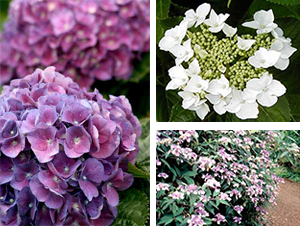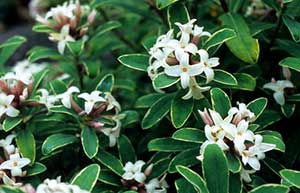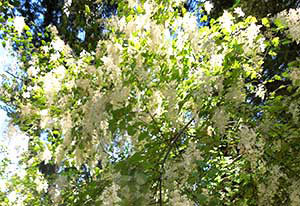Is Your Garden in the Doldrums? Plant These Trees and Shrubs for Stunning Summer Flowers
Professional Member, APLD
In Seattle, early spring thrills as cherries, rhododendrons, dogwoods, and other spring-flowering trees and shrubs come into bloom. But how is your garden faring now that summer has arrived and with it a long string of dry, warm, sunny days? Does it look tired? Are you nostalgic for those spring flowers and feel there is nothing more to anticipate? Well, think again. This article suggests some outstanding trees and shrubs that flower during the warmest and driest summer months.
Hydrangeas: Queens of the Summer Garden

Lavender mophead flowers of Hydrangea macrophylla ‘Nikko Blue’ begin blooming in early to mid summer.
Image Courtesy of ©Missouri Botanical Garden Kemper Center, courtesy Great Plant Picks
Hydrangea macrophylla ‘Lanarth White’ has white lacecap flowers from early summer through September.
Image Courtesy of ©Joy Creek Nursery, courtesy Great Plant Picks
Rough-leaf hydrangea (Hydrangea aspera Villosa Group) flowers in August and September.
Image Courtesy of ©Joy Creek Nursery, courtesy Great Plant Picks
Summer-flowering Trees

The June flowers of Cornus kousa ‘Satomi’, a pink form of disease-resistant Korean dogwood, are followed by strawberry-like fruits in August.
Image Courtesy of Janine Anderson
Stewartia pseudocamellia produces camellia-like white flowers in midsummer.
Image Courtesy of ©Mary Randlett, courtesy Great Plant Picks
Lagerstroemia indica ‘Natchez’ is one of many varieties of summer-flowering crape myrtles.
Image Courtesy of ©Treeland Nurseries, Mesa, AZ
Flowering around the same time are many varieties of Korean dogwood (Cornus kousa). Unlike the ubiquitous white and pink forms of Eastern dogwood (Cornus florida), the later-flowering Korean dogwoods are disease resistant. Ornamental strawberry-like fruits follow the flowers, and the leaves turn strikingly red and orange in fall.
Varieties of Crape myrtle (Lagerstroemia indica) are widely planted throughout hot summer areas of the United States, particularly in southern states. Cultivars vary in size, form, bark, fall color, and disease resistance, but all are perfectly hardy in Seattle. Like tomatoes, some cultivars flower earlier than others, and the earlier-flowering varieties are the ones most likely to produce showy flowers in the Pacific Northwest, which has cooler summer temperatures than many other areas of the United States. A sheltered, sunny, heat-absorbing site offers the greatest likelihood of flowering. Flower colors differ widely by variety, from pure white to deep pink, magenta, and lavender.
For Something Completely Different

Summer-flowering Chaste tree (Vitex agnus-castus) has fine, aromatic foliage.
Image Courtesy of Image courtesy of Sten Porse, Wikimedia Commons
Similar to the Chaste tree, Bluebeard (Caryopteris x clandonensis) is drought and heat tolerant and deer resistant. The variety ‘Dark Night’ reaches only 4 by 4 feet and has dark green, aromatic foliage and deep purple flowers beloved by hummingbirds and butterflies alike.
Would You Prefer Something Heavenly Scented?

The perfume of Daphne × transatlantica ‘Summer Ice’ can waft through your garden for up to 6 months!
Image Courtesy of ©Richie Steffen, courtesy Great Plant Picks
At only 3 by 3 feet, Daphne × transatlantica ‘Eternal Fragrance’ produces soft pink flowers in spring that continue into summer and fall. The similarly sized Daphne tangutica has shiny, deep green leaves and produces tubular, pale pink flowers in spring that often continue throughout summer.
Go Native

The lilac-like creamy white flowers of Ocean Spray (Holodiscus discolor) are lovely along the trail, and in your border.
Image Courtesy of Janine Anderson
